By: Leah Smith
This article originally appeared in the Spring 2021 issue of BEEKeeping Your First Three Years
“The pedigree of honey does not concern the bee; A clover, any time, to him is aristocracy.” – Emily Dickinson
How true! If you consult any number of sources that report on plants which provide the most nectar to honey bees, clovers will be crowding out most others for the top slots on the list. True clovers are members of the genus Trifolium. There are roughly 300 species in this genus of the Fabaceae (legume) family. Clovers, in addition to their familiar and occasionally lucky foliage, have flower heads that are, in fact, very dense spikes of many flowers, either red, purple, white, or yellow in color. As members of the legume family, they are known collectively for their nitrogen fixation capabilities; however, the amount of nitrogen fixed varies from species to species. All clovers are also well known for their usefulness in pastures; they grow abundantly and re-grow readily, and are palatable and nutritious to livestock. You should also note that clover pastures themselves benefit from the activities of honey bees; their pollination means an increase in seed production by the clover, providing dependable reseeding for the coming years.
Productiveness as pasture and providing nectar (and pollen) to honey bees are desirable reasons to plant clover, but which clover should you plant? As a homesteader, I appreciate that each clover has its own unique traits; it is in comparing these differences that you will be able to make a decision. Some clovers are annuals, while others are biennials and still others perennials. They display different tolerances for growth in shade as well as the soil types and moisture levels they thrive in. And many of them have additional side benefits. The following are a handful of the wonderful clovers you have to choose from, with a few varieties highlighted specifically.
The Clovers
Trifolium pratense-Red Clover
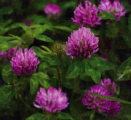 Red clover is a favorite for hay production due to its rapid growth, its popularity making it easy to source and low cost. Though many clover flower heads can be used for teas (and leaves are edible as well), the sweet and mild red clover is the preferred and traditional clover used by herbalists. A perennial plant that produces runners, it is therefore necessary to mow it for long-term management. A variety called medium red clover can be used as a cover crop over whole fields, but is also understated enough that it can be planted between rows of crops. Or…
Red clover is a favorite for hay production due to its rapid growth, its popularity making it easy to source and low cost. Though many clover flower heads can be used for teas (and leaves are edible as well), the sweet and mild red clover is the preferred and traditional clover used by herbalists. A perennial plant that produces runners, it is therefore necessary to mow it for long-term management. A variety called medium red clover can be used as a cover crop over whole fields, but is also understated enough that it can be planted between rows of crops. Or…
Mammoth Red Clover
As a more assertive option, choose mammoth red clover. It also has strong and rapid growth, and an ultimate height of roughly 3 feet; also a favorite for hay. It can be planted almost any time of year, another attractive characteristic. Mammoth red clover really distinguishes itself because of its tolerance of poor and acidic soils. This tolerance of poor soils can no doubt be partly attributed to its long taproots which can both loosen soil and recover phosphorus and other nutrients from the lower soil layers, and also to its high nitrogen fixation rate.
Trifolium repens-White or Dutch White
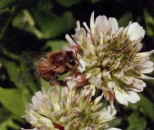 White clover is a perennial and very low growing for a clover (typically 8 to 12 inches in height). Its height is a real distinction between it and other clovers, and the reason why it is not planted in hay fields. It is also why it excels at its principle uses, which are as a lawn replacement and living mulch or green manure. Its ability to withstand mowing and its growth with runners make it ideal not simply as a lawn replacement but to endure areas of heavy traffic. Not only can it be planted as a straightforward Spring or Fall cover crop or green manure, but its manageable size makes it well suited to plant in between row crops as a living mulch. It is more tolerant of heat than other clovers, but it prefers cooler climates and, therefore, is fairly adaptable. It is also important to note that white clover honey is considered by many to be the benchmark of honeys. There are a number of varieties of white clover. Those of the ladino-type group do well on poorly drained soil, and though less durable than other white clovers are taller and exceptional nitrogen fixers, and so great choices for cover crop or green manure. Varieties of like “Rivendel” and “Dragon’s Blood” are excellent as ground covers in areas not necessarily for mowing but which require low-growing plants with decorative flair, due to their exceptionally attractive appearance. “Dragon’s Blood” has a green and white variegated leaf with a touch of red. Or…
White clover is a perennial and very low growing for a clover (typically 8 to 12 inches in height). Its height is a real distinction between it and other clovers, and the reason why it is not planted in hay fields. It is also why it excels at its principle uses, which are as a lawn replacement and living mulch or green manure. Its ability to withstand mowing and its growth with runners make it ideal not simply as a lawn replacement but to endure areas of heavy traffic. Not only can it be planted as a straightforward Spring or Fall cover crop or green manure, but its manageable size makes it well suited to plant in between row crops as a living mulch. It is more tolerant of heat than other clovers, but it prefers cooler climates and, therefore, is fairly adaptable. It is also important to note that white clover honey is considered by many to be the benchmark of honeys. There are a number of varieties of white clover. Those of the ladino-type group do well on poorly drained soil, and though less durable than other white clovers are taller and exceptional nitrogen fixers, and so great choices for cover crop or green manure. Varieties of like “Rivendel” and “Dragon’s Blood” are excellent as ground covers in areas not necessarily for mowing but which require low-growing plants with decorative flair, due to their exceptionally attractive appearance. “Dragon’s Blood” has a green and white variegated leaf with a touch of red. Or…
New Zealand White Clover
Try a notable variety of white clover, namely New Zealand white clover. It has the same basic characteristics, but it is yet more heat tolerant than other clovers, white or otherwise. It is also more vigorous and tolerant of a wider variety of soil types than other white clovers. New Zealand white clover is often used for erosion control, for which its root system is particularly well suited; though it is a traditional leguminous taproottype system as it begins to grow, it is replaced with a rather fibrous system after a few years when the taproot dies off. This root system also helps to contribute to its high organic matter production. Recent studies have shown that while aboveground plant growth plays a role in carbon sequestration and organic matter production, of course, the extent of these activities below ground is more significant to a plant’s ultimate totals.
Trifolium incarnatum-Crimson or Italian Clover
 Sown in late Summer, crimson clover spends the Winter dormant and resumes growth in Spring, providing flowers in May; it is therefore in place to provide a nitrogen boost to full-season crops.
Sown in late Summer, crimson clover spends the Winter dormant and resumes growth in Spring, providing flowers in May; it is therefore in place to provide a nitrogen boost to full-season crops.
This planting schedule allows it to grow in the cool, humid weather it prefers and avoid the heat of Summer (yet it could be planted for Summer as well). Crimson clover is an annual that does not spread by runners and so is relatively easy to eliminate by tillage, though if allowed to it will readily reseed itself. Its plant growth is very upright, reaching at least 18 inches in height, and this is an advantage when used for hay production. However, its erect habit and the incredibly striking appearance of the crimson clover flower (elongated spike and vivid red color) has also gained it favor as a roadside planting for highway beautification, and also as filler for fresh-cut flower bouquets. It prefers soils with good organic matter content (and will add value to the soil with its own high nitrogen fixation rate), but it will not thrive in acidic, sandy, or waterlogged soils. It is shade tolerant and so grows well if its seed is sown beneath other plants, which no doubt is why it is recommended for weed control. Its attraction for honey bees make it additionally useful if sown for weed control between suitably tall crop rows as a method to increase pollination (it is used in this way in blueberry fields).
Trifolium hybridum-Swedish or Alsike Clover
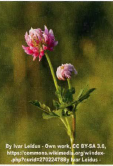
A perennial clover with white or lightly blushed flowers, Swedish or alsike clover is very Winter hardy and happy in generally cool conditions. It has a non-creeping growth habit; however, it grows from 2 to 4 feet tall, but will sprawl and display an apparently shorter profile. It prefers acidic soils, but is tolerant of more alkaline ones. An excellent choice for low and poorly drained ground, both of which it well tolerates (a characteristic that sets it apart from other clovers), Swedish clover, quite naturally, can also tolerate flooding but performs very poorly during periods of drought. It also prefers full sun and is not shade tolerant. Greatly liked by honey bees and other pollinators, this clover is often used in wildlife food plots. Note that it can be prone to dying out and so must be monitored.
Trifolium rubens-Pink, Ornamental, or Red Feather Clover
 Also called red trefoil, pink clover could be the most attractive of the clovers (though crimson clover gives it some stiff competition). It is therefore no surprise that it is generally considered purely ornamental. Attaining 18 to 24 inches in height, its large magenta to pink flowers emerge from attractive, silvery buds. This perennial prefers to grow in the full sun. Another noncreeping clover that stays in its place, this beauty is at home in flower beds to which it attracts both butterflies and hummingbirds (and honey bees, of course) and from which it is harvested for floral arrangements. However, not without a “practical” side, pink clover has aggressive roots that allow it to penetrate denser soil and that can even prevent erosion on ground as vulnerable as banks.
Also called red trefoil, pink clover could be the most attractive of the clovers (though crimson clover gives it some stiff competition). It is therefore no surprise that it is generally considered purely ornamental. Attaining 18 to 24 inches in height, its large magenta to pink flowers emerge from attractive, silvery buds. This perennial prefers to grow in the full sun. Another noncreeping clover that stays in its place, this beauty is at home in flower beds to which it attracts both butterflies and hummingbirds (and honey bees, of course) and from which it is harvested for floral arrangements. However, not without a “practical” side, pink clover has aggressive roots that allow it to penetrate denser soil and that can even prevent erosion on ground as vulnerable as banks.
Trifolium alexandrinum-Berseem or Egyptian Clover
 Another annual, berseem clover is a productive plant (typically achieving 18 to 30 inches in height) with ivory colored blossoms and a high rate of nitrogen fixation. Tolerant of a range of soil types (not including sand) and environmental temperatures, it is considered a high quality forage on par with alfalfa. It has the ability to withstand drought conditions, excess soil moisture (more so than alfalfa or sweet clover), and excess salinity (more so than alfalfa or red clover), and it will positively thrive in a loam soil which is slightly alkaline. Often planted as ground cover, a green manure, or as part of a wildlife food plot, berseem clover is additionally used for a late Summer planting to be a cover crop for Winter.
Another annual, berseem clover is a productive plant (typically achieving 18 to 30 inches in height) with ivory colored blossoms and a high rate of nitrogen fixation. Tolerant of a range of soil types (not including sand) and environmental temperatures, it is considered a high quality forage on par with alfalfa. It has the ability to withstand drought conditions, excess soil moisture (more so than alfalfa or sweet clover), and excess salinity (more so than alfalfa or red clover), and it will positively thrive in a loam soil which is slightly alkaline. Often planted as ground cover, a green manure, or as part of a wildlife food plot, berseem clover is additionally used for a late Summer planting to be a cover crop for Winter.
The Counterfeit Clovers
As you suspected, I couldn’t let the subject of clovers pass without mentioning two plants which, though not of the genus Trifolium and therefore not true clovers, are members of the Fabaceae family and have common names which allude to this familial connection. They are also quite pertinent to the subject of plants for happy honey bees.
Melilotus officinalis-Yellow Sweet Clover
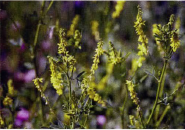 Yellow sweet clover is another top honey bee plant. Its appearance is dramatically different from that of the true clovers. It possesses bilateral flowers of a very similar appearance to that of true clovers, yet these flowers are not on a very dense flower spike but rather on very airy spacious spikes, giving them an elongated appearance. Unlike many of the true clovers, yellow sweet clover is very drought and heat tolerant, often growing in poor soils with no irrigation. Though it can be sown from Spring to Summer, early planting is often important as it can be slow to establish in general (at times requiring a nurse crop) and benefits from more favorable conditions.
Yellow sweet clover is another top honey bee plant. Its appearance is dramatically different from that of the true clovers. It possesses bilateral flowers of a very similar appearance to that of true clovers, yet these flowers are not on a very dense flower spike but rather on very airy spacious spikes, giving them an elongated appearance. Unlike many of the true clovers, yellow sweet clover is very drought and heat tolerant, often growing in poor soils with no irrigation. Though it can be sown from Spring to Summer, early planting is often important as it can be slow to establish in general (at times requiring a nurse crop) and benefits from more favorable conditions.
Once established, its deep taproot allows it to mine insoluble minerals like potassium and phosphorus from the lower regions of the soil profile, which combined with its high nitrogen fixation rate is why it is an excellent conditioner for poor soils. Once considered a weed, this valuable biennial produces blossoms heavy in pollen and nectar from April until July during its second year of growth, as well as reaching its ultimate height of up to six feet. Yellow sweet clover has better drought tolerance and greater biomass production than…
Melilotus alba-White Sweet Clover
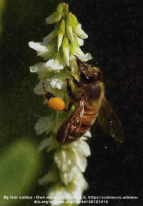 White sweet clover looks quite similar to yellow sweet clover except that, yes, it has little white flowers instead of yellow ones. The white flowers of this biennial bloom slightly later than their yellow counterparts, but for a longer season. White sweet clover needs help to attain its maximum biomass production (more so than the yellow), and must be supplied with sufficient moisture and/ or planted early in order to become established prior to the onset of drought conditions. Though its biomass production isn’t quite as large as that of yellow sweet clover, it is a taller and “stemmier” plant, which some people feel leads to better soil improvement when incorporated into the soil. As with the yellow, white sweet clover has an impressive taproot; thus, both are known for nutrient mining, lessening the impacts of compaction, great productivity in hot weather, and for being able to grow almost anywhere (though they are not overly fond of acid soils).
White sweet clover looks quite similar to yellow sweet clover except that, yes, it has little white flowers instead of yellow ones. The white flowers of this biennial bloom slightly later than their yellow counterparts, but for a longer season. White sweet clover needs help to attain its maximum biomass production (more so than the yellow), and must be supplied with sufficient moisture and/ or planted early in order to become established prior to the onset of drought conditions. Though its biomass production isn’t quite as large as that of yellow sweet clover, it is a taller and “stemmier” plant, which some people feel leads to better soil improvement when incorporated into the soil. As with the yellow, white sweet clover has an impressive taproot; thus, both are known for nutrient mining, lessening the impacts of compaction, great productivity in hot weather, and for being able to grow almost anywhere (though they are not overly fond of acid soils).
And there you have it, a collection of clovers. Bear in mind that for them to be of advantage to your bees in addition to offering their other benefits, they must be managed in a way that allows them to flower, which is not necessarily observing the same schedule as when they are used solely for soil improvement, as a forage, etc. But with the appropriate management, clovers can provide your bees with a nectar source and pollen from April to November. “To live in clover” means to have a carefree life of ease and prosperity. The question with clovers, then, is not if you should provide your bees with these valuable plants, but which one(s) to choose.










